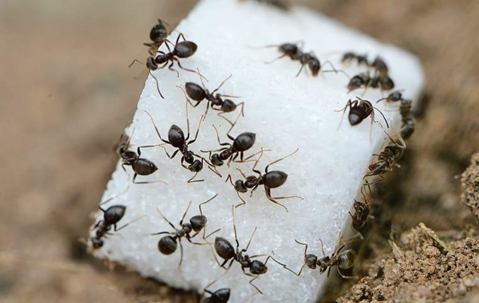Winter is an exciting time. The holiday season is approaching, the air feels refreshing, and something about the bare, leafless trees can be so picturesque. However, we all know that winter has its downside: ice on the windshield in the morning, dangerous road conditions, and bugs. Wait a minute. Did we say bugs? Unfortunately, just because the temperatures drop doesn’t mean that the frost will kill off all of the home-invading pests on your property. Ants, for instance, might actually become more of a nuisance in the winter months.
Desperate Times
Just like humans have their own routine for preparing for the winter, ants also prepare themselves for the drop in temperature with a unique natural process. In order to conserve what little warmth they can hold on to, ants slow their bodies down and reduce their core temperature, allowing them to survive the winter (at a very slow pace). Outside in the cold, ants can only move so quickly, but they don’t have to eat as much food since their bodies are only performing at partial capacity.
While they’re moving sluggishly through your Moline yard, however, any source of warmth will be attractive. That’s why they’ll gravitate towards your home during the winter months. Many of the well-prepared ants may have even snuck into your house as the temperatures began to drop and are now nesting within your walls. Rather than exiting the house to search for food, the cold temperatures will force them to set their sights inward.
Unfortunately, one of the most common winter-nesting ants is also one of the most destructive. Carpenter ants get their name from their ability to scrape out the wooden pieces of your home’s foundation in order to build nests. They are active year-round, but they might be more noticeable in the winter if they stop going outside to look for food. These large, black ants do not eat your wood as termites do, but they can cost hundreds of dollars in repair costs, given enough time.
Preventing Winter Woes
If you’re seeing any sort of ants in your house during the winter, they may already have nests in your house, which means the problem may be too far gone for your own preventative measures. Signs of carpenter ant presence include things like sawdust along the baseboards, tightening of the doors and windows, shed swarmer wings on the ground, and any damage to visible wood. If you don’t see the signs, then you should shift your focus to preventing future issues with the following methods:
Control moisture issues with dehumidifiers.
Trim back trees to prevent potential roof entry.
Clean regularly to prevent loose crumbs.
Store food and trash properly.
Seal cracks and crevices with extra caulking.
Monitor screens for holes, tears, and separations.
Understand that you can check off all of these boxes and still wind up with ant problems in the winter. Carpenter ants are a common and costly pest that can be nearly impossible to get rid of on your own. Home remedies and store-bought sprays tend to have inconsistent results, and you might not know the full extent of the problem, exposing yourself to more home damage.
The only guaranteed way to get rid of an ant infestation within the home, especially carpenter ants, is with professional assistance from Quik-Kill Pest Eliminators. Our professional pest technicians have years of experience dealing with carpenter ants, so they know just where to look to eradicate the nests completely. Plus, our preventative solutions can keep your home ant-free for all of the winters to come. Give us a call today to find out more.

